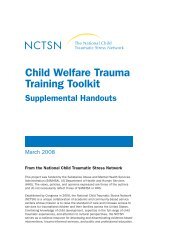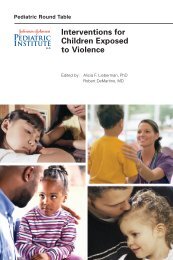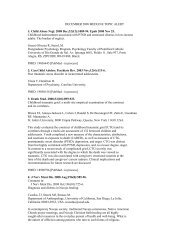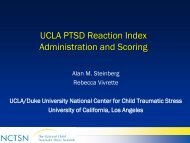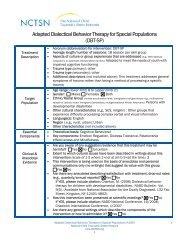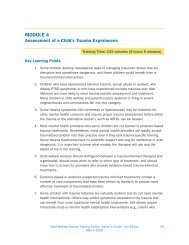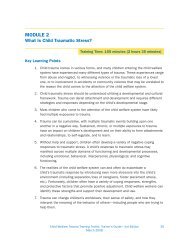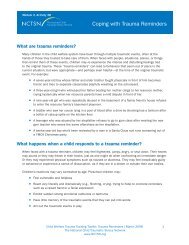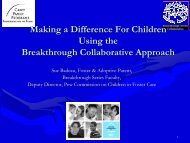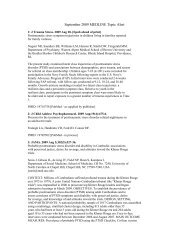NCTSN Empirically Supported Treatments and Promising Practices
NCTSN Empirically Supported Treatments and Promising Practices
NCTSN Empirically Supported Treatments and Promising Practices
You also want an ePaper? Increase the reach of your titles
YUMPU automatically turns print PDFs into web optimized ePapers that Google loves.
<strong>NCTSN</strong> <strong>Empirically</strong> <strong>Supported</strong> <strong>Treatments</strong> <strong>and</strong> <strong>Promising</strong> <strong>Practices</strong><br />
(Listed Alphabetically, with Level of Evidence*)<br />
Treatment <strong>and</strong> Developer Site Level of Evidence* Description<br />
Abuse-focused Cognitive Behavioral Therapy for<br />
Child Abuse<br />
Western Psychiatric Institute <strong>and</strong> Clinic<br />
Pittsburgh, PA<br />
Attachment, Self-Regulation, <strong>and</strong> Competence (ARC):<br />
A Common-Sense Framework for Intervention with<br />
Complexly Traumatized Youth<br />
The Trauma Center<br />
Allston, MA<br />
Biofeedback Assisted Reduction of PTSD Symptoms<br />
Aurora Mental Health Center<br />
Aurora, CO<br />
Child Development-Community Policing Program (CDCP)<br />
Yale Child Study Center, New Haven Department of Police<br />
Service<br />
New Haven, CT<br />
Child-Parent Psychotherapy for Family Violence<br />
Early Trauma Treatment Network<br />
San Francisco, CA<br />
Children Affected by Domestic Violence<br />
Children's Institute International<br />
Los Angeles, CA<br />
Cognitive Behavioral Intervention for Trauma in Schools<br />
RAND Corporation, Los Angeles Unified School District, &<br />
UCLA Los Angeles, CA<br />
Combined Parent Child Cognitive-Behavioral Approach for<br />
Children <strong>and</strong> Families At-Risk for Child Physical Abuse<br />
NJCARES Institute<br />
UMDNJ-SOM<br />
Stratford, NJ<br />
Combined TF-CBT <strong>and</strong> SSRI Treatment<br />
Allegheny General Hospital Center for Traumatic Stress in<br />
Children <strong>and</strong> Adolescents, Pittsburgh, PA<br />
COPE-Community Outreach Program<br />
National Crime Victims Research <strong>and</strong> Treatment Center<br />
Charleston, SC<br />
Family Advocate Program<br />
National Children’s Advocacy Center<br />
Huntsville, AL<br />
Forensically Sensitive Therapy<br />
National Children’s Advocacy Center<br />
Huntsville, AL<br />
IFACES- International Family Adolescent <strong>and</strong><br />
Children’s Services<br />
Heartl<strong>and</strong> Health Outreach<br />
Chicago, IL<br />
Modified Dialectical Behavioral Therapy with<br />
Developmentally Disabled Children<br />
Aurora Mental Health Center<br />
Aurora, CO<br />
<strong>Supported</strong> <strong>and</strong><br />
Probably Efficacious<br />
<strong>Promising</strong> <strong>and</strong> Acceptable<br />
Novel <strong>and</strong> Experimental<br />
<strong>Supported</strong> <strong>and</strong> Acceptable<br />
Well <strong>Supported</strong> <strong>and</strong> Efficacious<br />
<strong>Supported</strong> <strong>and</strong> Acceptable<br />
<strong>Supported</strong> <strong>and</strong><br />
Probably Efficacious<br />
<strong>Supported</strong> <strong>and</strong> Acceptable<br />
<strong>Supported</strong> <strong>and</strong> Acceptable<br />
<strong>Supported</strong> <strong>and</strong> Acceptable<br />
<strong>Promising</strong> <strong>and</strong> Acceptable<br />
<strong>Promising</strong> <strong>and</strong> Acceptable<br />
<strong>Promising</strong> <strong>and</strong> Acceptable<br />
Novel <strong>and</strong> Experimental<br />
<strong>NCTSN</strong> <strong>Empirically</strong> <strong>Supported</strong> <strong>Treatments</strong> <strong>and</strong> <strong>Promising</strong> <strong>Practices</strong><br />
3.22.05 -- www.<strong>NCTSN</strong>et.org<br />
↓ Parent to child aggression, abuse risk<br />
↓child to parent aggression & externalizing<br />
behaviors,<br />
less family conflict & greater cohesion<br />
Clinic or alternative residential setting<br />
Age: school age<br />
↓Trauma symptoms<br />
↑ attachment(s), regulatory capacity, competency, <strong>and</strong><br />
systems of care<br />
implemented in school, community, or clinic settings All<br />
ages<br />
↓Trauma symptoms<br />
anxiety management<br />
Age:13-17<br />
Collaborative model: Police & Mental Health<br />
professionals, Crisis intervention & follow-up,<br />
Community based, All ages, Community/Family<br />
Violence<br />
↑ parent child relationship<br />
↑IQ, ↓child behavior problems<br />
↓child PTSD symptoms, ↓ symptoms of anxious<br />
attachment, ↓maternal PTSD<br />
Clinic or home setting<br />
Age: infants, toddlers, <strong>and</strong> preschoolers<br />
↓Trauma symptoms<br />
Group symptoms<br />
Age: Children 5+ & nonoffending parent<br />
↓PTSD symptoms<br />
↓Depression<br />
↓Parent-reported behavior problems<br />
Schools<br />
Age: 10 – 15<br />
↓ PTSD, depression, abuse-related attributions, &<br />
externalizing behavior problems in children.<br />
↓ Parental anger, behavior management skills, parent<br />
to child violence, & parent-child relationship.<br />
Children, ages: 4-17, <strong>and</strong> caregivers<br />
↓Trauma symptoms<br />
Age: 10-18<br />
↓Trauma symptoms<br />
TF-CBT, PCIT framework + Case management<br />
Applied in home, school based settings<br />
Age 4-18<br />
Wraparound services<br />
For non-offending caregivers in families reported for<br />
abuse or domestic violence<br />
↓Trauma symptoms<br />
sexual abused<br />
Age: 4-17<br />
individual treatment<br />
Refugee children<br />
Comprehensive services<br />
↓Trauma symptoms<br />
↓ Emotion & Behavior Dysregulation<br />
Age:10-14<br />
1
Multimodality Trauma Treatment (MMTT)<br />
Center for Child & Family Health/Duke University<br />
Durham, NC<br />
Parent-Child Interaction Therapy<br />
Sheila Eyberg, PhD, University of Florida<br />
Gainesville, FL<br />
Real Life Heroes<br />
Parsons Child Trauma Study Center<br />
Albany, NY<br />
Safe Harbor Program: A School-based Victim<br />
Assistance & Violence Prevention Program<br />
Safe Horizon<br />
New York, NY<br />
Sanctuary Model<br />
Jewish Board of Family <strong>and</strong> Children’s Services<br />
Westchester, NY<br />
Sanctuary® Plus (IRIS Project)<br />
Community Works, Philadelphia, PA; Parsons Child Trauma<br />
Study Center, Albany, NY; Jewish Board of Child <strong>and</strong> Family<br />
Services, New York, NY; Andrus Children’s Services,<br />
Yonkers, NY<br />
Skills Training in Affective & Interpersonal<br />
Regulation/Narrative Story Telling (STAIR/NST)<br />
The Institute for Trauma & Stress at NYU Child Study Center<br />
New York, NY<br />
Southeast Asian Teen Village<br />
Mental Health Center of Dane County Inc., Child,<br />
Adolescent <strong>and</strong> Family Services<br />
Madison, WI<br />
Streetwork Project<br />
Safe Horizon<br />
New York, NY<br />
Structured Psychotherapy for Adolescents Responding to<br />
Chronic Stress (SPARCS)<br />
Adolescent Trauma Treatment Development Center,<br />
Division of Child <strong>and</strong> Adolescent Psychiatry, North Shore<br />
University Hospital, Manhasset, NY<br />
Trauma Adaptive Recovery Group Education & Therapy for<br />
Adolescents <strong>and</strong> Pre-Adolescents (TARGET)<br />
University of Connecticut<br />
Farmington, CT<br />
Trauma-Focused Cognitive Behavioral Therapy<br />
Allegheny General Hospital Center for Traumatic Stress in<br />
Children <strong>and</strong> Adolescents, Pittsburg, PA<br />
& New Jersey CARES Institute<br />
Trauma-Focused Cognitive Behavioral Therapy for<br />
Childhood Traumatic Grief<br />
Allegheny General Hospital Center for Traumatic Stress<br />
Pittsburgh, PA<br />
Trauma Systems Therapy<br />
Boston University Medical Center<br />
Boston, MA<br />
UCLA Trauma/Grief Program for Adolescents<br />
UCLA National Center for Child Traumatic Stress<br />
Los Angeles, CA<br />
<strong>Supported</strong> <strong>and</strong> Acceptable<br />
<strong>Supported</strong> <strong>and</strong><br />
Probably Efficacious<br />
<strong>Supported</strong> <strong>and</strong> Acceptable<br />
<strong>Supported</strong> <strong>and</strong> Acceptable<br />
<strong>Supported</strong> <strong>and</strong> Acceptable<br />
<strong>Promising</strong> <strong>and</strong> Acceptable<br />
<strong>Supported</strong> <strong>and</strong> Acceptable<br />
Novel <strong>and</strong> Experimental<br />
<strong>Promising</strong> <strong>and</strong> Acceptable<br />
<strong>Supported</strong> <strong>and</strong> Acceptable<br />
<strong>Promising</strong> <strong>and</strong> Acceptable<br />
Well <strong>Supported</strong> <strong>and</strong> Efficacious<br />
<strong>Supported</strong> <strong>and</strong><br />
Probably Efficacious<br />
<strong>Supported</strong> <strong>and</strong> Acceptable<br />
<strong>Supported</strong> <strong>and</strong> Acceptable<br />
<strong>NCTSN</strong> <strong>Empirically</strong> <strong>Supported</strong> <strong>Treatments</strong> <strong>and</strong> <strong>Promising</strong> <strong>Practices</strong><br />
3.22.05 -- www.<strong>NCTSN</strong>et.org<br />
↓PTSD ,depression, anxiety, anger<br />
group therapy (or individual)<br />
School, clinic, residential settings<br />
Age: 9+<br />
↑ parenting skills<br />
↑ parent child relationship<br />
↓ child externalizing behaviors<br />
↓ parent to child physical abuse<br />
age: 4 – 12<br />
↓ Loss, violence, neglect, abuse, complex trauma<br />
↑ placement, safety, attachment, affect regulation,<br />
skill building, creative arts, life story work<br />
CBT components, & psycho-education<br />
Age 6-13, adaptable for adolescents<br />
↓Trauma symptoms<br />
↑ parent involvement<br />
Includes school wide campaign<br />
Age 6-20<br />
↑ Emotional Regulation<br />
Psycho-education<br />
Therapeutic community<br />
Residential Treatment : age 6+<br />
Residential treatment for traumatized children<br />
Integrated model of Sanctuary, START, & Real-Life<br />
Heroes<br />
Age: 6+<br />
↓ PTSD symptoms<br />
↓anger, dissociation, depression, internalizing, &<br />
externalizing behavior<br />
↑ Social competency & emotional regulation<br />
Age: 12-21<br />
Southeast Asian Youth including refugees<br />
Psycho-spiritual approach combined with CBT<br />
Case management <strong>and</strong> community based mentoring<br />
Bi-lingual/bicultural capacity<br />
Age 12-19<br />
Stabilization<br />
↓Trauma symptoms<br />
Homeless<br />
age 15-23<br />
↓Symptoms resulting from chronic traumatic stress<br />
↑ Social competency & emotional regulation<br />
Group Treatment (based on CBT <strong>and</strong> DBT)<br />
Males <strong>and</strong> females; Age 13-21<br />
↓Trauma symptoms<br />
↑ Emotional Regulation<br />
Community, School or residential juvenile justice<br />
settings<br />
Age: 10-18<br />
↓Child PTSD symptoms, depression, anxiety,<br />
externalizing behaviors, sexualized behaviors, feelings<br />
of shame, <strong>and</strong> mistrust.<br />
↑ parenting practices<br />
↓Trauma & grief symptoms<br />
Clinic, school, community setting<br />
Age 6-17<br />
↓Trauma symptoms<br />
↑ Emotional Regulation<br />
↑ system of care<br />
stabilized social environment<br />
Age: 6-18<br />
↓Trauma & grief symptoms<br />
clinic or school<br />
age: 11-18<br />
2
<strong>NCTSN</strong> <strong>Empirically</strong> <strong>Supported</strong> <strong>Treatments</strong> & <strong>Promising</strong> <strong>Practices</strong>:<br />
Other Approaches<br />
(Listed Alphebtically)<br />
Below are <strong>Promising</strong> <strong>Practices</strong> that are not characterized as treatment interventions, but rather are unique approaches that<br />
some Network programs have developed to provide better access to care for traumatized children. These strategies include<br />
evaluation, assessment, administrative, <strong>and</strong> social marketing tool.<br />
<strong>Promising</strong> Practice <strong>and</strong> Developer Site Description<br />
Better Todays. Better Tomorrows for<br />
Children’s Mental Health (B2T2)<br />
Idaho State University Institute of Rural Health<br />
Boise, ID<br />
Implementation of St<strong>and</strong>ardized Measures in<br />
Community-Based Mental Health Program<br />
The Child Trauma Consortium of Westchester (CTCW)<br />
Westchester, NY<br />
Integrated Child Abuse Treatment:<br />
An <strong>Empirically</strong> Based Dynamic Strategy<br />
Child Trauma Treatment Network Intermountain West<br />
Salt Lake City, UT<br />
* Level of Evidence is based upon published, peer-reviewed data (provided by developers as of 17 February 2005) using the<br />
accompanying treatment classification criteria utilized by the “Office of Victims of Crime Guidelines for the Psychosocial<br />
Treatment of Intrafamilial Child Physical <strong>and</strong> Sexual Abuse.” Full version available at www.musc.edu/cvc/guide1.htm. Summary<br />
version available at www.<strong>NCTSN</strong>et.org. The Fact Sheets that accompany this table may also include unpublished data, which are<br />
not considered in the assigned Level of Evidence.<br />
↑ = Increases<br />
↓ = Decreases<br />
Public awareness targeting 12-15 years of age<br />
↑ treatment seeking<br />
Implementation protocol for st<strong>and</strong>ardized assessment tools<br />
Integrated continuous quality improvement, model for empirically based practice<br />
This project was funded by the Substance Abuse <strong>and</strong> Mental Health Services Administration (SAMHSA), US<br />
Department of Health <strong>and</strong> Human Services (HHS). The views, policies, <strong>and</strong> opinions expressed are those of the<br />
authors <strong>and</strong> do not necessarily reflect those of SAMHSA or HHS.<br />
National Child Traumatic Stress Network<br />
www.<strong>NCTSN</strong>et.org<br />
<strong>NCTSN</strong> <strong>Empirically</strong> <strong>Supported</strong> <strong>Treatments</strong> <strong>and</strong> <strong>Promising</strong> <strong>Practices</strong><br />
3.22.05 -- www.<strong>NCTSN</strong>et.org<br />
3


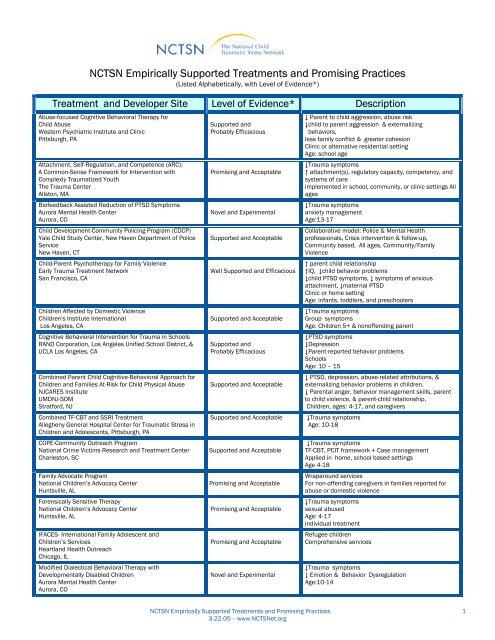
![Chinese [PDF | 949 KB] - National Child Traumatic Stress Network](https://img.yumpu.com/21942479/1/184x260/chinese-pdf-949-kb-national-child-traumatic-stress-network.jpg?quality=85)
